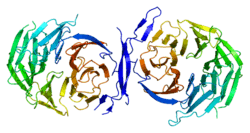TLE3
Transducin-like enhancer protein 3 is a protein that in humans is encoded by the TLE3 gene.[3][4]
References
Further reading
- Stifani S, Blaumueller CM, Redhead NJ, Hill RE, Artavanis-Tsakonas S (Oct 1992). "Human homologs of a Drosophila Enhancer of split gene product define a novel family of nuclear proteins". Nature Genetics. 2 (2): 119–27. doi:10.1038/ng1092-119. PMID 1303260.
- Liu Y, Dehni G, Purcell KJ, Sokolow J, Carcangiu ML, Artavanis-Tsakonas S, Stifani S (Jan 1996). "Epithelial expression and chromosomal location of human TLE genes: implications for notch signaling and neoplasia". Genomics. 31 (1): 58–64. doi:10.1006/geno.1996.0009. PMID 8808280.
- Wang JC, Waltner-Law M, Yamada K, Osawa H, Stifani S, Granner DK (Jun 2000). "Transducin-like enhancer of split proteins, the human homologs of Drosophila groucho, interact with hepatic nuclear factor 3beta". The Journal of Biological Chemistry. 275 (24): 18418–23. doi:10.1074/jbc.M910211199. PMID 10748198.
- Nagase T, Kikuno R, Nakayama M, Hirosawa M, Ohara O (Aug 2000). "Prediction of the coding sequences of unidentified human genes. XVIII. The complete sequences of 100 new cDNA clones from brain which code for large proteins in vitro". DNA Research. 7 (4): 273–81. doi:10.1093/dnares/7.4.271. PMID 10997877.
- Yao J, Lai E, Stifani S (Mar 2001). "The winged-helix protein brain factor 1 interacts with groucho and hes proteins to repress transcription". Molecular and Cellular Biology. 21 (6): 1962–72. doi:10.1128/MCB.21.6.1962-1972.2001. PMC 86788
 . PMID 11238932.
. PMID 11238932.
- Nuthall HN, Joachim K, Palaparti A, Stifani S (Dec 2002). "A role for cell cycle-regulated phosphorylation in Groucho-mediated transcriptional repression". The Journal of Biological Chemistry. 277 (52): 51049–57. doi:10.1074/jbc.M111660200. PMID 12397081.
- López-Ríos J, Tessmar K, Loosli F, Wittbrodt J, Bovolenta P (Jan 2003). "Six3 and Six6 activity is modulated by members of the groucho family". Development. 130 (1): 185–95. doi:10.1242/dev.00185. PMID 12441302.
- Beausoleil SA, Jedrychowski M, Schwartz D, Elias JE, Villén J, Li J, Cohn MA, Cantley LC, Gygi SP (Aug 2004). "Large-scale characterization of HeLa cell nuclear phosphoproteins". Proceedings of the National Academy of Sciences of the United States of America. 101 (33): 12130–5. doi:10.1073/pnas.0404720101. PMC 514446
 . PMID 15302935.
. PMID 15302935.
- Beausoleil SA, Villén J, Gerber SA, Rush J, Gygi SP (Oct 2006). "A probability-based approach for high-throughput protein phosphorylation analysis and site localization". Nature Biotechnology. 24 (10): 1285–92. doi:10.1038/nbt1240. PMID 16964243.
- Olsen JV, Blagoev B, Gnad F, Macek B, Kumar C, Mortensen P, Mann M (Nov 2006). "Global, in vivo, and site-specific phosphorylation dynamics in signaling networks". Cell. 127 (3): 635–48. doi:10.1016/j.cell.2006.09.026. PMID 17081983.
- Tu LC, Yan X, Hood L, Lin B (Apr 2007). "Proteomics analysis of the interactome of N-myc downstream regulated gene 1 and its interactions with the androgen response program in prostate cancer cells". Molecular & Cellular Proteomics. 6 (4): 575–88. doi:10.1074/mcp.M600249-MCP200. PMID 17220478.
- Ewing RM, Chu P, Elisma F, Li H, Taylor P, Climie S, McBroom-Cerajewski L, Robinson MD, O'Connor L, Li M, Taylor R, Dharsee M, Ho Y, Heilbut A, Moore L, Zhang S, Ornatsky O, Bukhman YV, Ethier M, Sheng Y, Vasilescu J, Abu-Farha M, Lambert JP, Duewel HS, Stewart II, Kuehl B, Hogue K, Colwill K, Gladwish K, Muskat B, Kinach R, Adams SL, Moran MF, Morin GB, Topaloglou T, Figeys D (2007). "Large-scale mapping of human protein-protein interactions by mass spectrometry". Molecular Systems Biology. 3 (1): 89. doi:10.1038/msb4100134. PMC 1847948
 . PMID 17353931.
. PMID 17353931.
PDB gallery |
|---|
|
| 1gxr: WD40 REGION OF HUMAN GROUCHO/TLE1 |
| 2ce8: AN EH1 PEPTIDE BOUND TO THE GROUCHO-TLE WD40 DOMAIN. |
| 2ce9: A WRPW PEPTIDE BOUND TO THE GROUCHO-TLE WD40 DOMAIN. |
|
|




 . PMID 11238932.
. PMID 11238932. . PMID 15302935.
. PMID 15302935. . PMID 17353931.
. PMID 17353931.

